On February 25th of each year, Guatemala commemorates the “National Day of Dignification for the Victims of the Internal Armed Conflict (IAC).” Survivors and family members marched on Sunday the 25th from the Human Rights Plaza at the Palace of Justice to the National Palace of Culture, in zone 1 of Guatemala City to honor through songs, ceremonies, and altars the lives of the more than 200,000 people killed and 45,000 disappeared during the Internal Armed Conflict in Guatemala.
The struggle for the dignification of the victims of the Internal Armed Conflict in Guatemala has been ongoing for decades, demanding truth, justice and non-repetition of these crimes. On February 25th, 1999, the Commission for Historical Clarification’s report, “Guatemala: Memory of Silence,” was delivered in Guatemala City. It revealed the truth about human rights violations during the Internal Armed Conflict. In 2004, the Congress of the Republic approved by law the establishment of February 25th of each year as the National Day of Dignification for the Victims of the Internal Armed Conflict (IAC).
During the commemoration, survivors of the conflict were received by the Vice President, Karin Herrera, at the National Palace of Culture for the symbolic act of changing the Peace Rose, continuing to demand in this act that the President Arévalo and Vice President Herrera resume the reparation policies established in the Peace Agreements to continue the search for truth and justice.
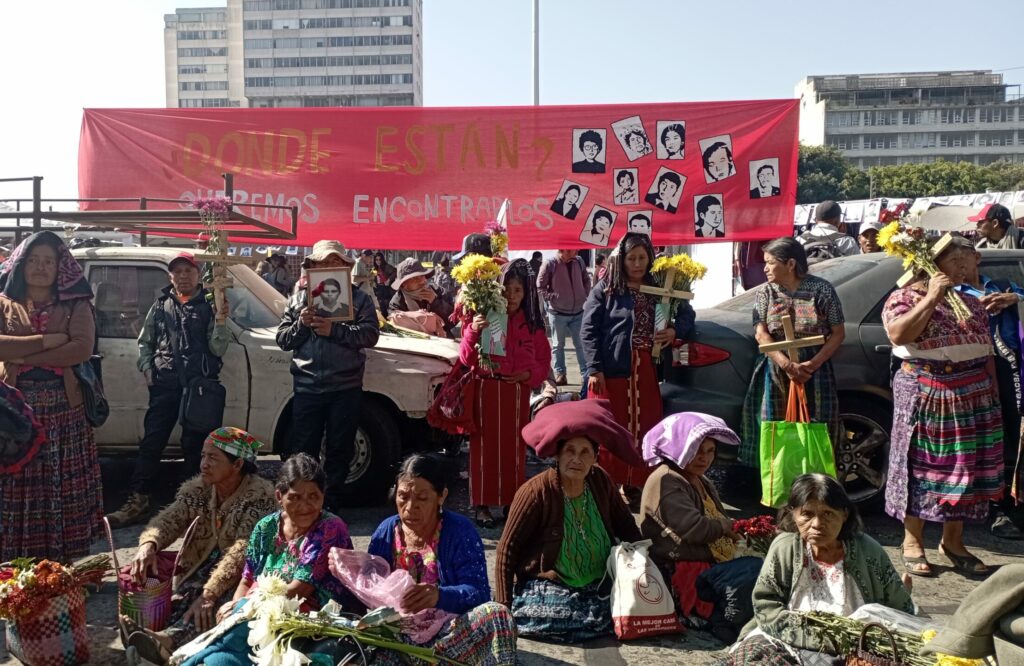
Photo by NISGUA. Survivors and relatives of victims present at the commemoration of the National Day of Dignification for the Victims of the Internal Armed Conflict (IAC) in front of the National Palace in Guatemala City. Sunday, February 25, 2024.
During the event in zone 1 of the Capital City, people offered words of remembrance for those who gave their lives in Guatemala for social justice, towards a different Guatemala.
Fragment of the reading of the statement read by relatives of victims of the Internal Armed Conflict, Guatemala City, February 25th, 2024. (only available in Spanish)
The people of Guatemala, today, and every day of the year, fight to preserve memory so that the children and grandchildren know history, so that all that has been lived is not forgotten, until truth and justice flourish. The people of Guatemala also fight for justice, “Until we find them” can be heard in front of the Central Plaza and in the streets of the city, until all the corrupt people, who hinder the finding of truth and justice for capitalist and colonial interests, are in prison as well as the material and intellectual actors who committed violations against the people of Guatemala.
Guatemala is a country of people who every day dare to fight for a different country.
Photographs by NISGUA. Expressions of commemoration on the National Day of Dignification for the Victims of the Internal Armed Conflict (IAC) in Guatemala.
During that day, collectives of people and organized communities were present to accompany the survivors and relatives of victims of the Internal Armed Conflict. The Collective Hijos e Hijas Guatemala por la Identidad y la Justicia con el Olvido, y el Silencio (Children for the Identity and Justice for the Forgotten and Silenced Guatemala), Genocide Never again Coalition and the Collective Estamos Aquí (We Are Here), amplified the voices for the historical memory, from their creative expressions of resistance they honor all persons and relatives who were taken away by the army and for whom justice is still demanded.
Photographs by NISGUA. Altar installation by the Collective Hijxs Guatemala (Children Guatemala) in front of the National Palace, zone 1, Guatemala City.
During the Internal Armed Conflict in Guatemala, thousands of children were also victims, taken from their homes through fraudulent adoptions. Some of these children, now adults, were present at the commemoration and are working to keep this crime present in history and seek to reestablish family ties as part of the process of healing and justice. Through the wheatpasting of the streets of Guatemala, they seek to position the importance of respecting the rights of children today and the non-repetition of past abuses.
Photo by NISGUA: Wheatpastes and posters in the Central Plaza, zone 1, Guatemala City. February 25, 2024
Also during the commemoration, the organizations spoken out about the responsibility of the United States in the financing and arming of the army in Guatemala, fueling and aggravating the genocide of the Indigenous Peoples during the Internal Armed Conflict. What it continues to do today by financing Israel to continue the war and genocide against the Palestinian people. Through the wallpaper in the streets of Guatemala, the people demand a Free Palestine and the accountability of the U.S. government for complicity in crimes against humanity that occurred in Guatemala during the armed conflict.
Photographs by NISGUA. Wheatpastings and paintings in solidarity with Palestine in the streets of the historical center of Guatemala City, zone 1.
Videos and photographs of expressions of resistance, resilience, memory, justice from the communities in the Constitution Square, in front of the National Palace, zone 1, Guatemala City, February 25, 2024. (Videos sound only available in Spanish)
A commemoration also took place in the Ixil territories, on February 24th the population was called to commemoration activities, during which the following statement was read from the Coordinadora de Organizaciones Ixiles (Coordinating Committee of Ixil Organizations).
As NISGUA we stand in solidarity with the survivors and relatives of victims of the Internal Armed Conflict in Guatemala. We echo the call to keep the memory alive, for the non-repetition of acts of violence against the people organized for the defense of their rights. It is a moment to continue amplifying the voices of the people of Guatemala, from wherever we are, #GenocideNeverAgain.

![14 [ENG] A painting with a white background and gold border with two black and white photographs of victims of the Internal Armed Conflict in Guatemala. Behind the painting is a cross painted in black with white letters that read: "1982," both supported by metal chairs, on one side there are yellow flowers.](https://nisgua.org/wp-content/uploads/14-2.jpeg)
![13 [ESP] Un muro de una calle de la ciudad de Guatemala, varios carteles empapelados que denuncian el rapto de niñez durante el conflicto armado interno, así como la búsqueda de justicia. [ENG] On a wall on a street in Guatemala City, several wheatpasted posters denouncing the abduction of children during the Internal Armed Conflict, and searching for justice.](https://nisgua.org/wp-content/uploads/13-1.jpeg)
![7 [ESP] Una fotografía de una persona víctima del conflicto armado interno siendo sostenido de costado por un familiar, solo se alcanza a ver una parte del brazo y mano de quien lo sostiene. También sostiene junto al cuadro unos claveles rojos. [ENG] A photograph of a victim of the Internal Armed Conflict being held on his side by a family member, only part of the arm and hand of the person holding him can be seen. They are also holding red carnations next to the picture.](https://nisgua.org/wp-content/uploads/7-2.jpeg)
![23 [ESP] Un stand metálico de pie en medio de la plaza central con muchas imágenes de fotografías en blanco y negro de personas víctimas del conflicto armado [ENG] A metal stand in the middle of the Central Square with many images of black and white photographs of victims of the armed conflict.](https://nisgua.org/wp-content/uploads/23-1.jpeg)
![21 [ESP] Una manta roja con letras blancas que dice: ”Nunca más rios de sangre en Guatemala” extendida sobre el suelo en la Plaza Central de Guatemala frente al palacio nacional. [ENG] A red banner with white letters that reads: "Never again rivers of blood in Guatemala" spread on the ground in Guatemala's Central Plaza in front of the national palace.](https://nisgua.org/wp-content/uploads/21-2.jpeg)
![16 [ESP] Filas de sillas metálicas color gris, cada una con una impresión de fotografías de personas víctimas del conflicto armado, un clavel rojo y una veladora descansa al costado de cada silla. [ENG] Rows of gray metal chairs, each with a print of photographs of victims of the armed conflict, a red carnation and a candle rests on the side of each chair.](https://nisgua.org/wp-content/uploads/16-1.jpeg)
![Instalacion HIJOS palacio nacional 1 [ESP] Filas de sillas metálicas color gris, cada una con una impresión de fotografías de personas víctimas del conflicto armado, un clavel rojo y una veladora descansa al costado de cada silla. [ENG] Rows of gray metal chairs, each with a print of photographs of victims of the armed conflict, a red carnation and a candle rests on the side of each chair.](https://nisgua.org/wp-content/uploads/Instalacion-HIJOS-palacio-nacional-1-scaled.jpg)
![Instalacion HIJOS palacio nacional 4 [ESP] Filas de sillas metálicas color gris, cada una con una impresión de fotografías de personas víctimas del conflicto armado, un clavel rojo y una veladora descansa al costado de cada silla. [ENG] Rows of gray metal chairs, each with a print of photographs of victims of the armed conflict, a red carnation and a candle rests on the side of each chair.](https://nisgua.org/wp-content/uploads/Instalacion-HIJOS-palacio-nacional-4-scaled.jpg)
![11 [ESP] Filas de sillas metálicas color gris, cada una con una impresión de fotografías de personas víctimas del conflicto armado, un clavel rojo y una veladora descansa al costado de cada silla. [ENG] Rows of gray metal chairs, each with a print of photographs of victims of the armed conflict, a red carnation and a candle rests on the side of each chair.](https://nisgua.org/wp-content/uploads/11-2.jpeg)
![Fotos de victimas CAI en el parque centra cd Guatemala [ESP] Filas de sillas metálicas color gris, cada una con una impresión de fotografías de personas víctimas del conflicto armado, un clavel rojo y una veladora descansa al costado de cada silla. [ENG] Rows of gray metal chairs, each with a print of photographs of victims of the armed conflict, a red carnation and a candle rests on the side of each chair.](https://nisgua.org/wp-content/uploads/Fotos-de-victimas-CAI-en-el-parque-centra-cd-Guatemala-scaled.jpg)
![5 [ENG] Black and white photography wheatpasted on the cement floor of the Central Plaza of Guatemala, of adults holding their photograph as children. Written on the upper part of the poster: "I am looking for my family."](https://nisgua.org/wp-content/uploads/5-4-e1709052451354.jpeg)
![2 [ENG] Imagen ilegible en blanco y negro enpapelada en el piso de cemento de la Plaza central de Guatemala, se alcanza a leer: “En Guatemala si hubo Genocidio. En Guatemala sí hubo tráfico de niñxs” [ENG] An illegible black and white image on the cement floor of Guatemala's central square reads: "In Guatemala there was Genocide. In Guatemala there was child trafficking".](https://nisgua.org/wp-content/uploads/2-2-e1709052370835.jpeg)
![29 [ESP] Un afiche a colores sostenido por una mano en medio de la Plaza Central de Guatemala, se lee: “Los desaparecidos y desaparecidas del conflicto armado, me faltan a mi, te faltan a vos” la imagen es un columpio vacío en el que se refleja la sombra de un columpio con un niñe. [ENG] A colorful poster held by a hand in the middle of the Central Plaza of Guatemala, reads: "The disappeared of the armed conflict, they are missing me, they are missing you" the image is an empty swing and a shadow of the swing, but with a child.](https://nisgua.org/wp-content/uploads/29.jpeg)
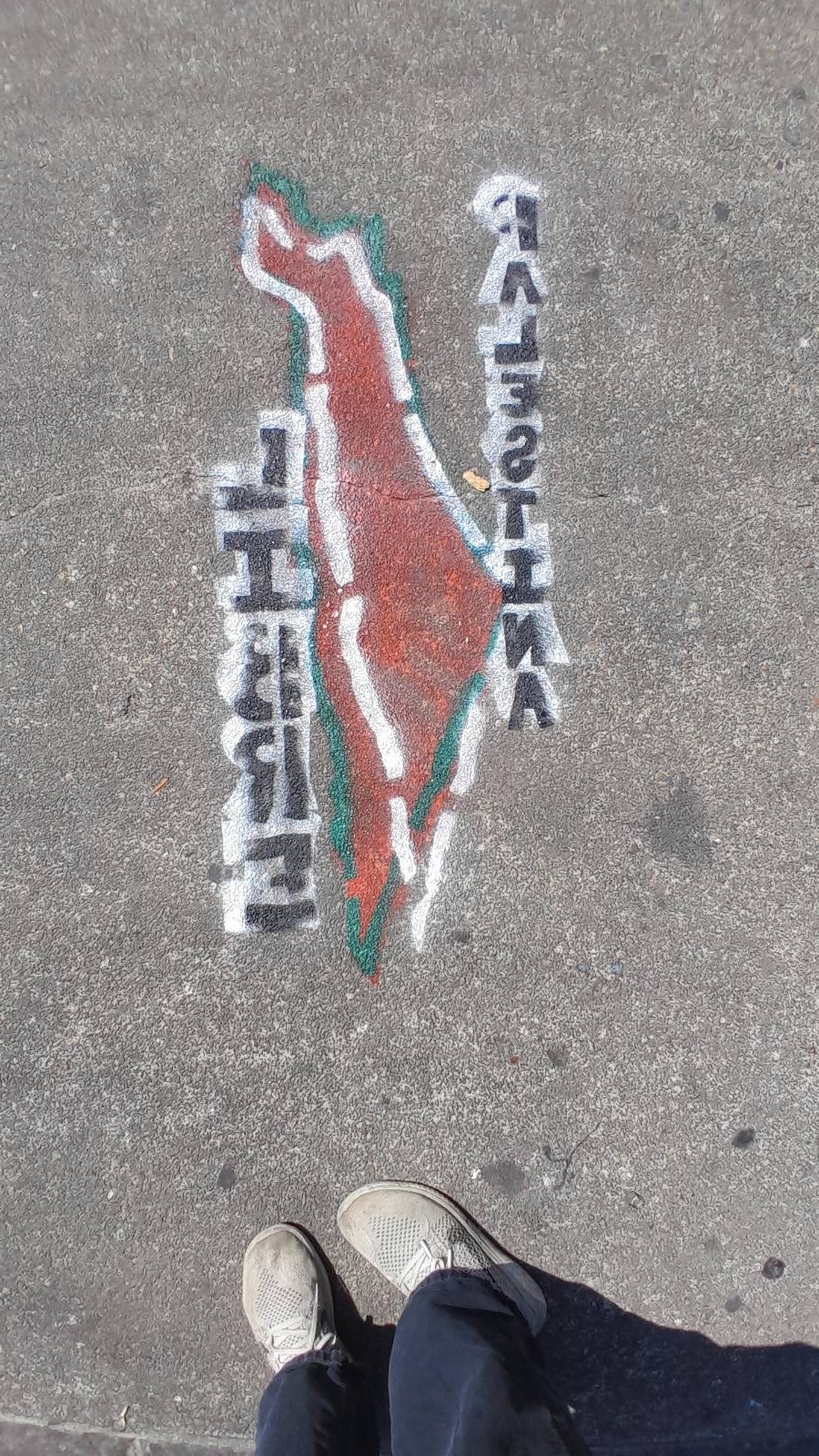
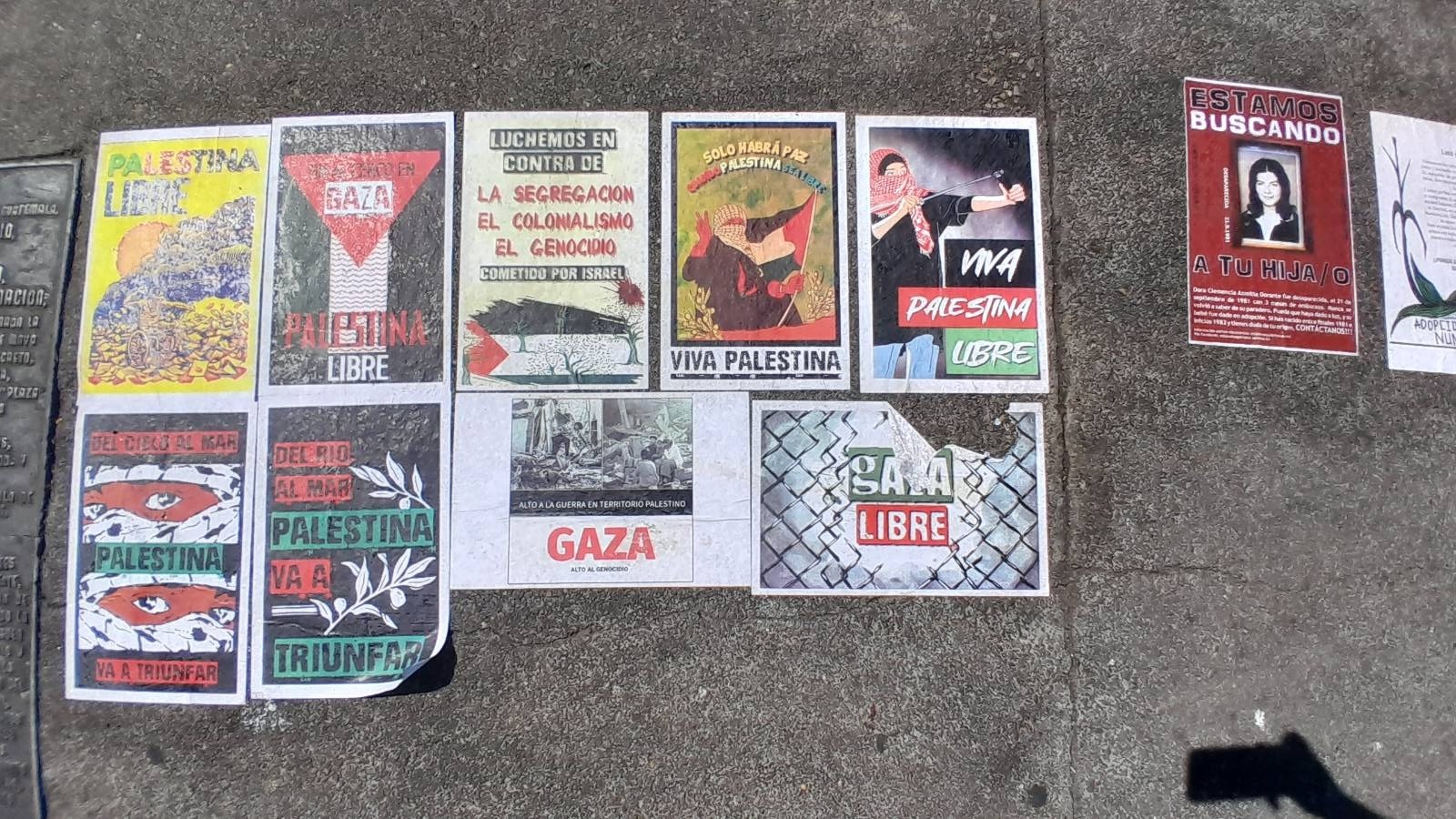
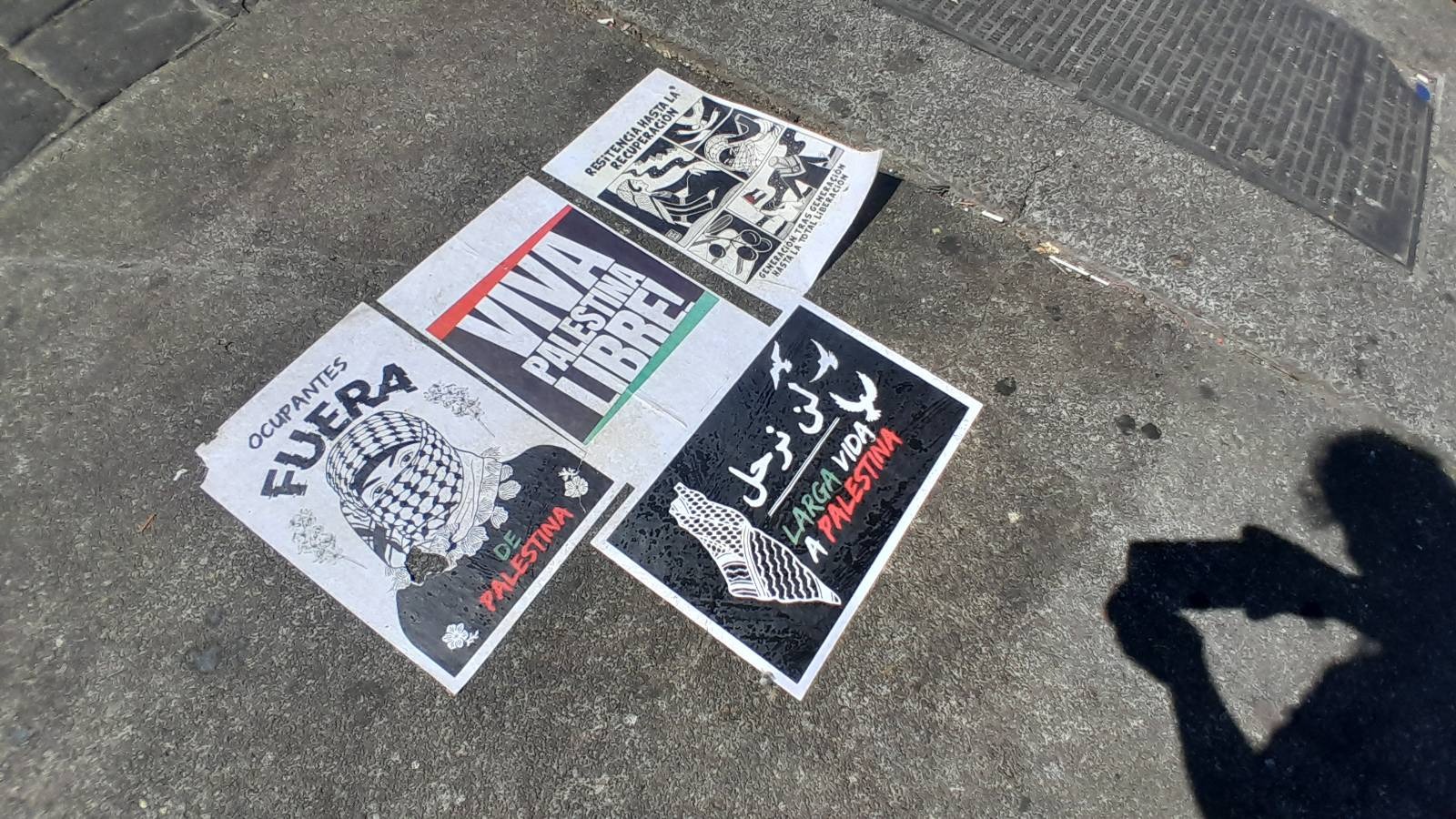
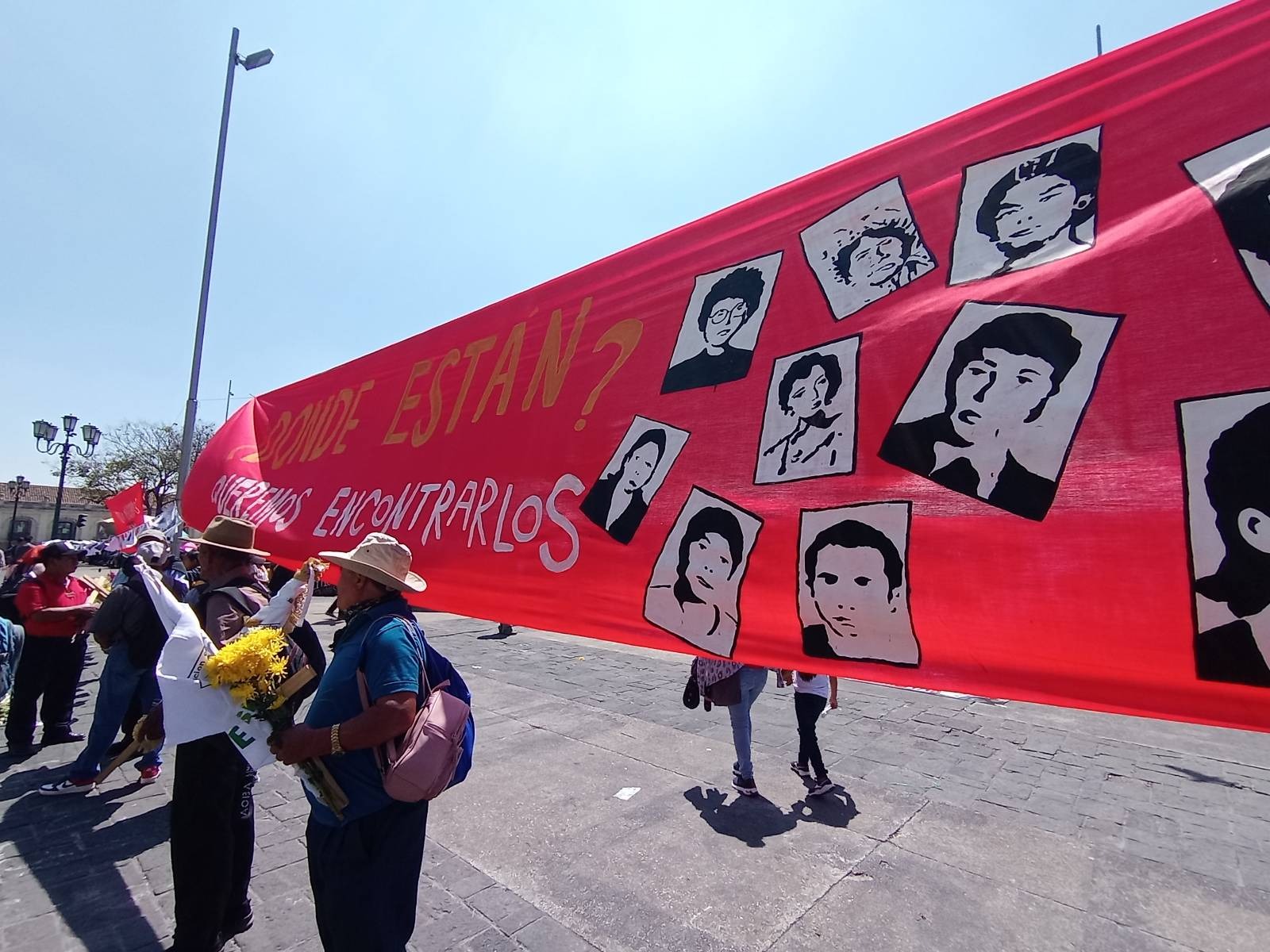
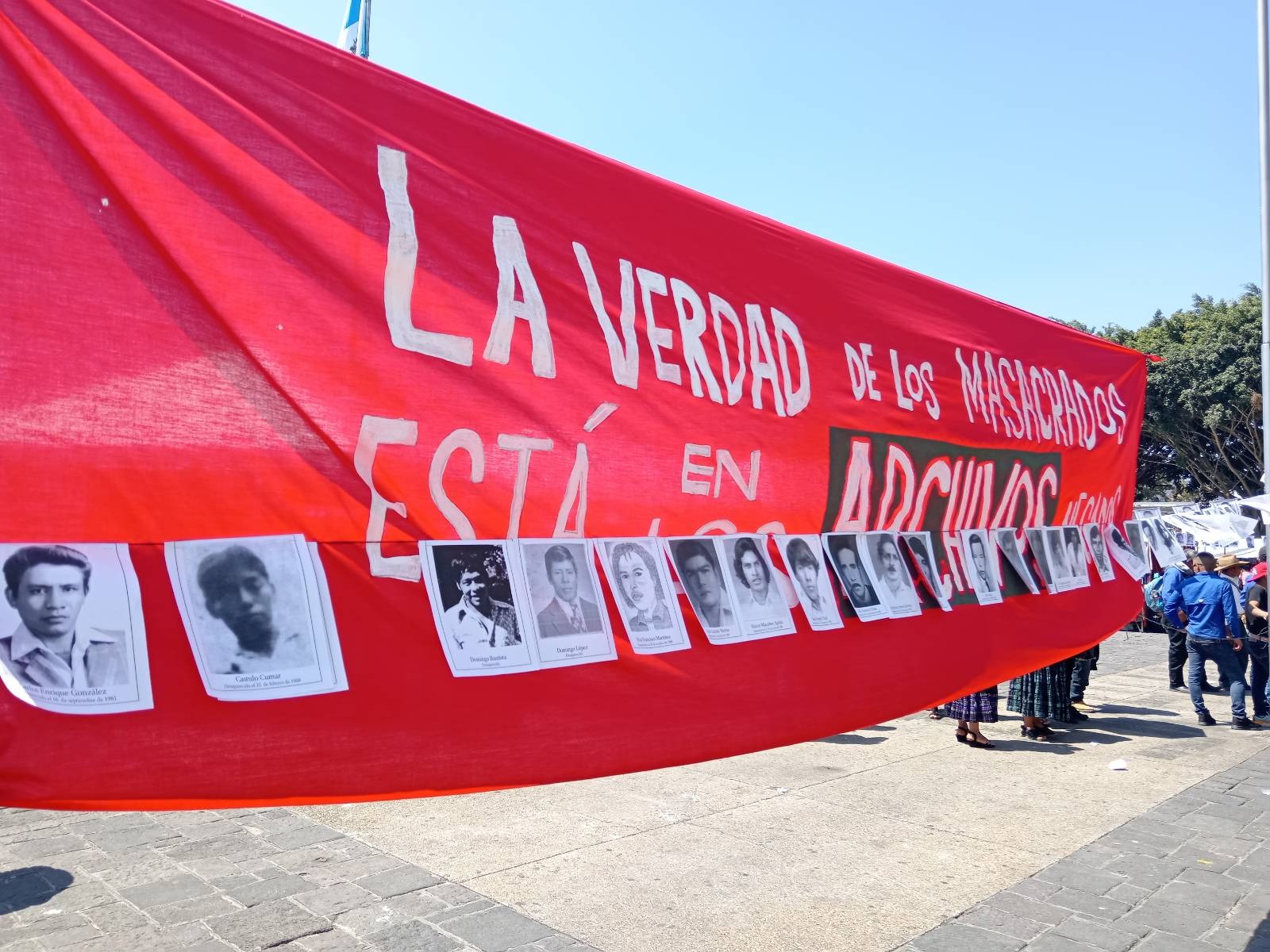
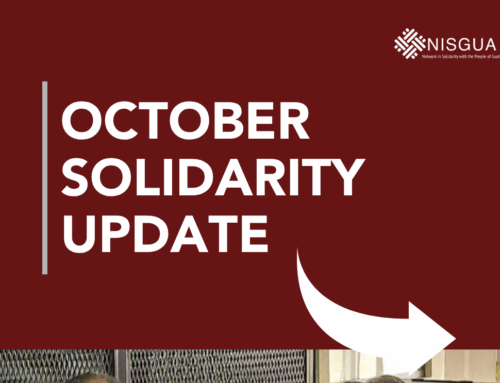
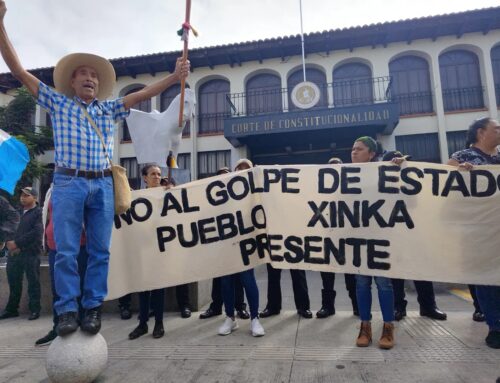
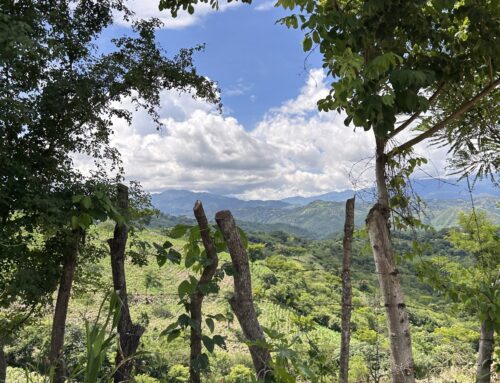
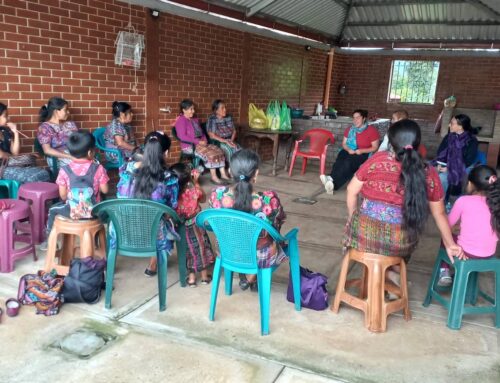
Leave A Comment